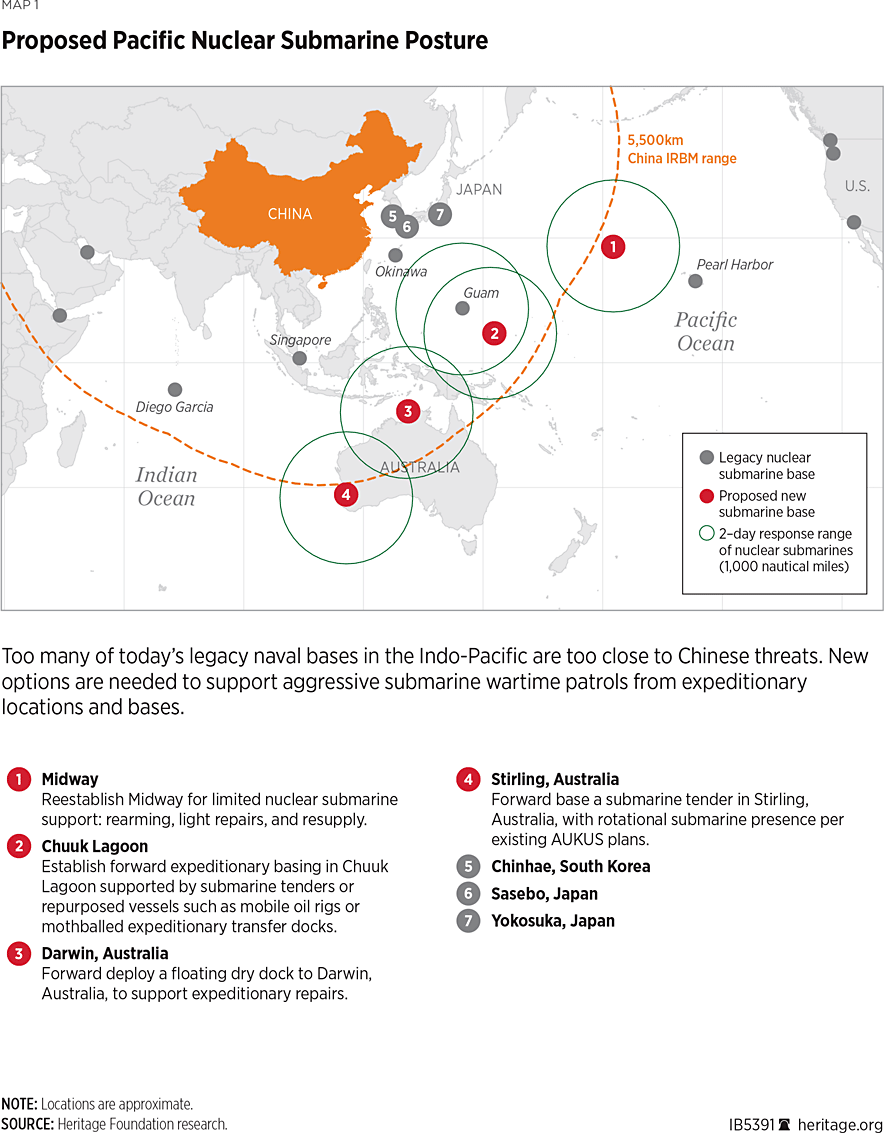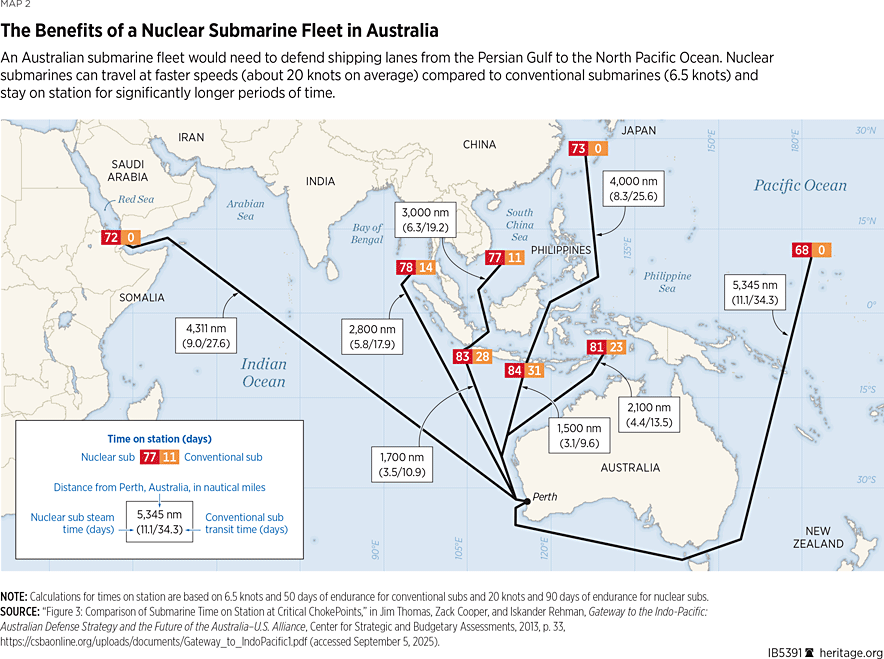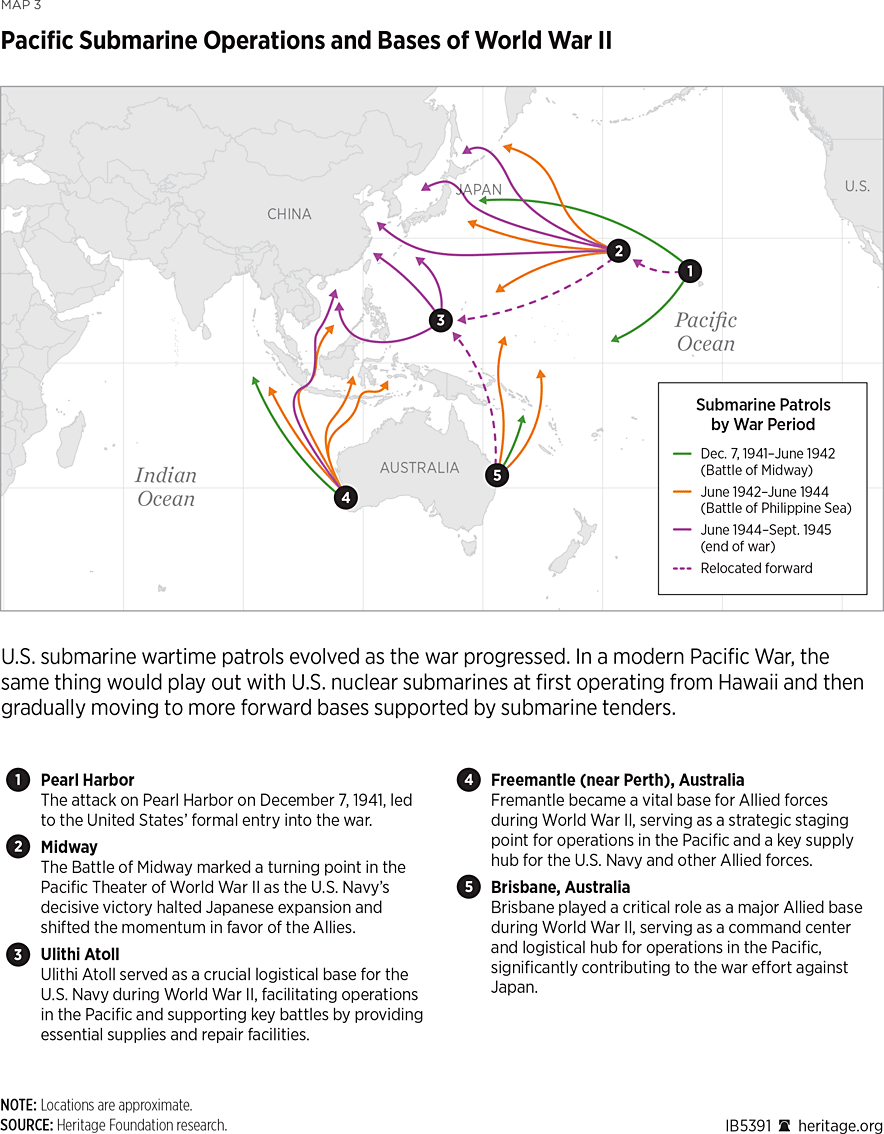Being present is obviously a prerequisite for effective alliances, but so is being able to apply leadership and direct resources where needed to advance important undertakings. Today, all are especially important in the Indo-Pacific where there is an urgent need for the U.S. to reestablish deterrence against Chinese adventurism. Tensions escalated to a new high on August 11, 2025, for example, when a Chinese destroyer collided with and severely damaged a Chinese Coast Guard cutter while attempting to ram a Philippine patrol vessel.REF
In such times, deterring China requires that the allied nuclear submarine presence in Asia be enhanced—an effort to which the Australia–United Kingdom–U.S. (AUKUS) trilateral security partnership can make a substantial contribution. By 2027, under the existing AUKUS plan, U.S. nuclear submarines will be rotationally based at HMAS Stirling, an hour’s drive south from Perth, Australia. During this same period, should things remain unchanged, China could prepare itself to wage a successful Pacific war. It is therefore essential that the United States use the next 18 months to get in place the naval forces that might still deter that war and, if needed, defeat China’s wartime goals.
In addition, success in the AUKUS endeavor can be better ensured with the reestablishment of the Navy’s First Fleet. This would provide an operationally focused fleet staff dedicated to executing regionally focused naval operations with on-site resources and leadership to accelerate preparation for the arrival and employment of future forces in the region.

The Optimum Pathway at a Crossroads
The so-called Optimum Pathway, which was announced on March 13, 2023, stipulates milestones for the AUKUS nations to achieve together in establishing a nuclear submarine force in Australia. The next major milestone is the arrival of nuclear submarines, the first of which will most likely be a U.S. Virginia-class sub, as part of the Submarine Rotational Force–West (SRF–West), which will be based in HMAS Stirling before the end of 2027.REF Such forward basing of warships optimizes time operating in waters near the threat and closest to allies.
The benefits of basing at HMAS Stirling can be expected to be the same as those achieved after Submarine Squadron 15 was established in 2001 on Guam.REF Assuming that specific shoreside sustainment infrastructure and workforces are in place, the planned “rotational”REF presence of nuclear submarines will have an immediate impact on sustained U.S. nuclear submarine presence in the Indian Ocean and Western Pacific.
Shoreside Needs and Implications of SRF–West
Various sustainment needs must be met before the first nuclear submarine to be based in HMAS Stirling arrives: for example, housing, employment for spouses, and school for dependents. But most critical is infrastructure to ensure safe operation and maintenance of nuclear submarines. Infrastructure requirements include “pure water” for nuclear plant use and facilities for the handling of limited radioactive liquid and materials produced during normal operation and maintenance of these submarines. Such facilities have been met or will be met before the arrival of the first submarine, but progress must nonetheless be tracked and certified.REF
One issue stands out: the provision of dry dock services should emergency repairs be required. Today, there is only one dry dock in Australia: Captain Cook Graving Dock, located two time zones away from HMAS Stirling in Sydney. This relic of World War II is not certified for nuclear submarines and is scheduled to be taken out of service for several years and upgraded.REF Given the time constraints, securing an existing and suitable floating dry dock is the most feasible way to ensure that this capability can be in place near HMAS Stirling by the time it is needed.
While a floating dry dock need not arrive before the first submarine makes Stirling home, the need is still urgent given significant waterfront construction planned in the nearby Henderson Defence Precinct where the Australian Navy maintains its warships and conducts shipbuilding.REF This activity includes the removal of a Chinese-owned Silver YachtREF currently located within the Henderson Precinct as well as establishment of significant chemical and rare earth processing facilities adjacent to it.REF All told, the industrial activity planned for these moves and updates to the waterfront, to include dry docks, will takes years to accomplish and are likely to have a significant impact on naval shoreside maintenance. This should be assumed given that the Osborne Shipyard located in Adelaide, Australia, is not expected to be ready to conduct major long-term nuclear submarine maintenance and construction for years.REF
In short, the presence of a floating dry dock certified for nuclear submarine maintenance present in the HMAS Stirling vicinity is the best option to ensure sustainment of nuclear submarines. It does this by providing a flexible, movable platform that can be shifted as warranted while waterfront construction proceeds in the coming years.
Enabling a More Robust Submarine Presence
As China nears its self-imposed deadline to be militarily ready to win a war against the U.S. over the fate of Taiwan by 2027, forward presence and sustainment capacities will be critical to deterring, let alone winning, such a war. Front and center in Beijing’s threat calculus is the need to contend with nuclear submarines that they currently have little capacity to thwart. The U.S., however, has too few: The goal is 66, but it possesses only 47.REF This means the U.S. must make every U.S. nuclear submarine count and be in the fight to the maximum extent that forward repair and replenishment options like those at HMAS Stirling allow. On Gardiner Island where HMAS Stirling is located, there are weapons magazines and explosive handling piers for torpedo reloads, and in time, there will also be the ability to conduct battle damage repairs—all within a week’s transit to the South China Sea.

Development of operationally important sustainment facilities, workforce training, and operational planning implies a staff dedicated to these tasks. Such a staff is being planned, but its arrival will be too late and it will be too narrowly focused unless accelerated and enhanced. Given the dangers of a war with China this decade, operational planning for a region-wide submarine campaign managed from a deployed headquarters is required. This was the case in World War II when nearby Fremantle became the hub for 416 allied wartime submarine patrols between March 1942 and August 1945, taking the fight to Imperial Japan deep into enemy waters.REF

Moreover, there is an opportunity to rally Southeast Asian partner and allied nations in a common cause and complicate Chinese operational planning for a future war. Among key considerations will be Chinese control of the approaches to Taiwan from the South China Sea, a decisive region in today’s peacetime New Cold War.REF Access and familiarity with the waters and ports in the region will be important before the fighting begins and can help to deter a Chinese military adventure this decade. Achieving this will require the leadership and commitment of resources that a numbered Navy fleet can provide.
In 2018, while the Seventh Fleet flagship Blueridge was conducting major repairs, a logistics support ship (T-EPF) was repurposed as a flagship for months of operations in Southeast Asia.REF This should be done again, this time for a small regionally focused First Fleet with a mission to complicate China’s peacetime grey-zone maritime operations.REF At the same time, this fleet’s minimal staff would be housed in HMAS Stirling with a second mission of accelerating and ensuring AUKUS progress and operational oversight of U.S. submarines based there. This can be achieved by moving a three-star vice admiral from a D.C. staff position and designating an activated T-EPF as a command ship. Such ships are currently in reduced status or deployed to the Western Pacific, notably to Singapore. Furthermore, the use of a T-EPF as a command ship makes sense given that its builder (Austal) operates a naval shipyard nearby in the Henderson Defence Precinct.REF This would ease sustainment of the command ship while in HMAS Stirling.
Correcting Course to Mitigate Risk in Meeting 2027 Deadlines
The potential for a violent showdown with China as early as 2027 is real and makes the forward posturing of forces a matter of considerable urgency. AUKUS offers both short-term and long-term opportunities to put in place the naval power that can deter China from this path. To take advantage of this opportunity and minimize the likelihood of conflict:
- The Secretary of the Navy should notify Congress of intent to reestablish First Fleet overseas. This should include the activation and repurpose of a T-EPF as the flagship on which a small regionally and AUKUS focus staff is based. The homeport for this ship can be rotationally based across the region with families and support staff located in HMAS Stirling to provide direct support to AUKUS efforts.
- The Secretary of Defense and Director of the Office of Management of Budget should issue budget guidance to fund the establishment of First Fleet with associated operational monies. This will be necessary to ensure the availability by 2027 of adequate staff and a T-EPF that has been modified to function as a command ship. Additionally, operational monies will be critically needed to support an increased naval presence in the South China Sea.
- The Commander of Indo-Pacific Command should issue planning orders and guidance for execution of a maritime counterinsurgency effort in the South China Sea led by Commander First Fleet. This order will be important to ensure joint military activities coordinated as part of a regional maritime approach that is intended to confound Chinese maritime grey-zone activities while gaining added access to regional ports and facilities.
- The Commander Pacific Fleet, with concurrence from the Chief of Naval Operations, should issue orders for a small regional and nuclear specialist support staff to be deployed to HMAS Stirling. This staff would be deployed initially for six months and would augment personnel already planned to arrive in HMAS Stirling in support of AUKUS. The option would be left open to extend the assignment of personnel to two or three years. This staff would consist of planning officers for exercises and operations, nuclear trained personnel focused on shoreside nuclear support associated with AUKUS, a personal staff for the commander, and a communications team to support at-sea operations. This staff could be drawn from regional exercise and operations staff based in Yokosuka, Japan, Seventh Fleet headquarters and the destroyer squadron seven (DESRON 7) staff in Singapore.
- The President should name a vice admiral as commander of First Fleet. The designation of a flag officer for a reestablished numbered fleet requires presidential nomination and concurrence from Congress. Given the strategic implications and game-changing nature of a refocused naval presence in the decisive South China Sea, direct presidential involvement would signal the backing of the highest office to regional partners while ensuring interagency support.
Conclusion
As China nears its self-imposed deadline to be militarily ready to win a war against the U.S. over Taiwan by 2027, forward presence and sustainment capacities will be critical to deterring, let alone winning, such a war. The clock is ticking, and bold action is needed. One act with significant strategic implications would be the modest reestablishment of First Fleet. This fleet would be led by a senior naval officer with a small staff focused on accelerating the Australia–United Kingdom–U.S. partnership and overseeing a maritime campaign to confound China’s coercive activities in the vital South China Sea. Such action would close a gap in the first island chain defenses and harden the region against Chinese military adventurism.
Brent D. Sadler is Senior Research Fellow for Naval Warfare and Advanced Technology in the Douglas and Sarah Allison Center for National Security at The Heritage Foundation.



